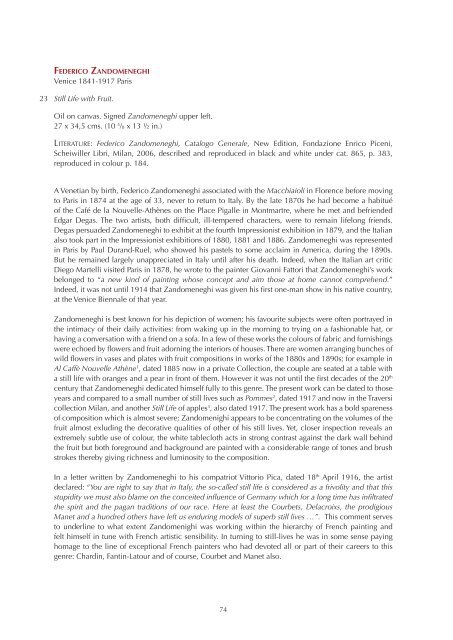Catalogue-2014-Jean-Luc-Baroni
- No tags were found...
You also want an ePaper? Increase the reach of your titles
YUMPU automatically turns print PDFs into web optimized ePapers that Google loves.
Federico Zandomeneghi<br />
Venice 1841-1917 Paris<br />
23<br />
Still Life with Fruit.<br />
Oil on canvas. Signed Zandomeneghi upper left.<br />
27 x 34,5 cms. (10 5 /8 x 13 ½ in.)<br />
Literature: Federico Zandomeneghi, Catalogo Generale, New Edition, Fondazione Enrico Piceni,<br />
Scheiwiller Libri, Milan, 2006, described and reproduced in black and white under cat. 865, p. 383,<br />
reproduced in colour p. 184.<br />
A Venetian by birth, Federico Zandomeneghi associated with the Macchiaioli in Florence before moving<br />
to Paris in 1874 at the age of 33, never to return to Italy. By the late 1870s he had become a habitué<br />
of the Café de la Nouvelle-Athènes on the Place Pigalle in Montmartre, where he met and befriended<br />
Edgar Degas. The two artists, both difficult, ill-tempered characters, were to remain lifelong friends.<br />
Degas persuaded Zandomeneghi to exhibit at the fourth Impressionist exhibition in 1879, and the Italian<br />
also took part in the Impressionist exhibitions of 1880, 1881 and 1886. Zandomeneghi was represented<br />
in Paris by Paul Durand-Ruel, who showed his pastels to some acclaim in America, during the 1890s.<br />
But he remained largely unappreciated in Italy until after his death. Indeed, when the Italian art critic<br />
Diego Martelli visited Paris in 1878, he wrote to the painter Giovanni Fattori that Zandomeneghi’s work<br />
belonged to “a new kind of painting whose concept and aim those at home cannot comprehend.”<br />
Indeed, it was not until 1914 that Zandomeneghi was given his first one-man show in his native country,<br />
at the Venice Biennale of that year.<br />
Zandomeneghi is best known for his depiction of women; his favourite subjects were often portrayed in<br />
the intimacy of their daily activities: from waking up in the morning to trying on a fashionable hat, or<br />
having a conversation with a friend on a sofa. In a few of these works the colours of fabric and furnishings<br />
were echoed by flowers and fruit adorning the interiors of houses. There are women arranging bunches of<br />
wild flowers in vases and plates with fruit compositions in works of the 1880s and 1890s; for example in<br />
Al Caffè Nouvelle Athène 1 , dated 1885 now in a private Collection, the couple are seated at a table with<br />
a still life with oranges and a pear in front of them. However it was not until the first decades of the 20 th<br />
century that Zandomeneghi dedicated himself fully to this genre. The present work can be dated to those<br />
years and compared to a small number of still lives such as Pommes 2 , dated 1917 and now in the Traversi<br />
collection Milan, and another Still Life of apples 3 , also dated 1917. The present work has a bold spareness<br />
of composition which is almost severe; Zandomenighi appears to be concentrating on the volumes of the<br />
fruit almost exluding the decorative qualities of other of his still lives. Yet, closer inspection reveals an<br />
extremely subtle use of colour, the white tablecloth acts in strong contrast against the dark wall behind<br />
the fruit but both foreground and background are painted with a considerable range of tones and brush<br />
strokes thereby giving richness and luminosity to the composition.<br />
In a letter written by Zandomeneghi to his compatriot Vittorio Pica, dated 18 th April 1916, the artist<br />
declared: “You are right to say that in Italy, the so-called still life is considered as a frivolity and that this<br />
stupidity we must also blame on the conceited influence of Germany which for a long time has infiltrated<br />
the spirit and the pagan traditions of our race. Here at least the Courbets, Delacroixs, the prodigious<br />
Manet and a hundred others have left us enduring models of superb still lives …”. This comment serves<br />
to underline to what extent Zandomenighi was working within the hierarchy of French painting and<br />
felt himself in tune with French artistic sensibility. In turning to still-lives he was in some sense paying<br />
homage to the line of exceptional French painters who had devoted all or part of their careers to this<br />
genre: Chardin, Fantin-Latour and of course, Courbet and Manet also.<br />
74
















